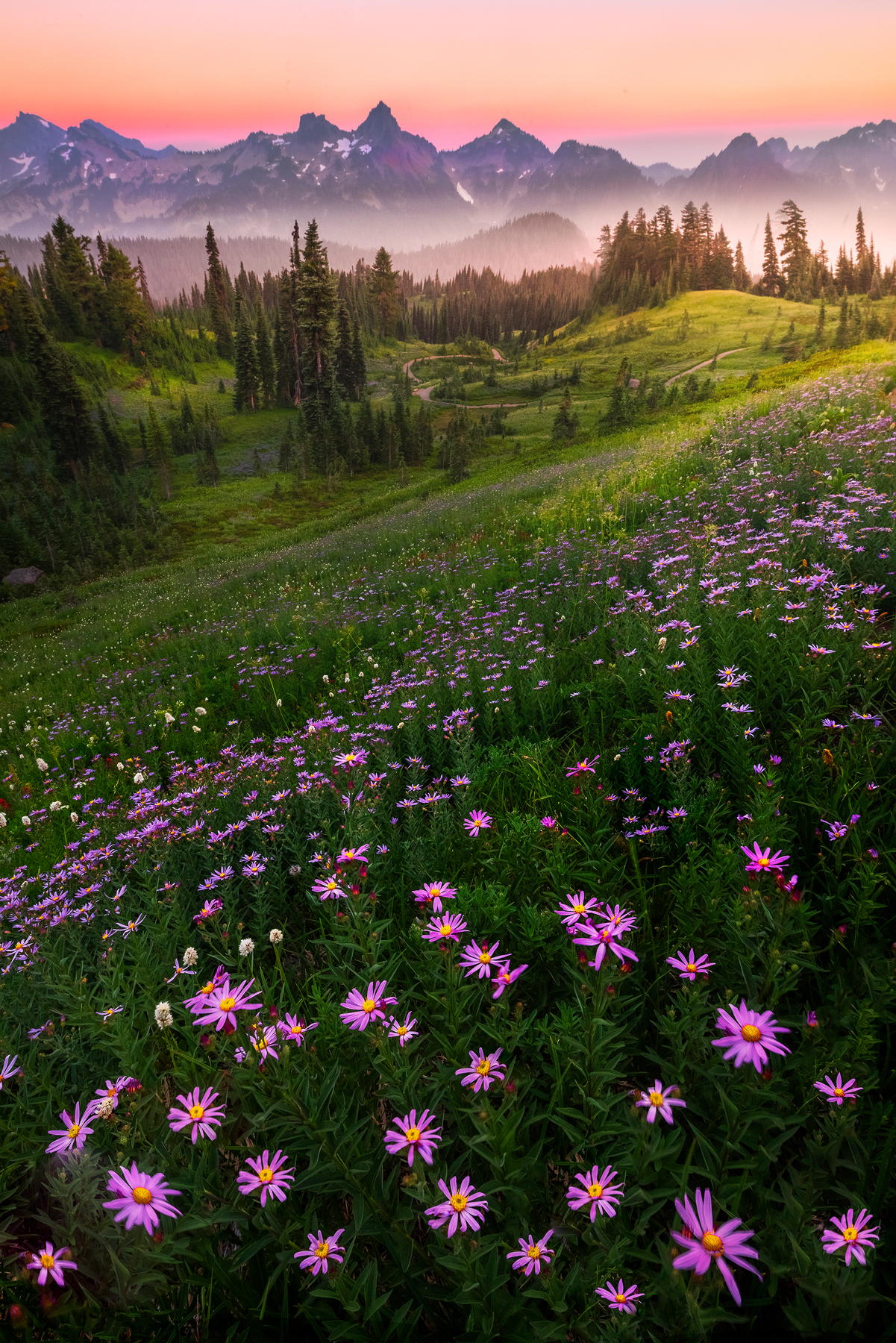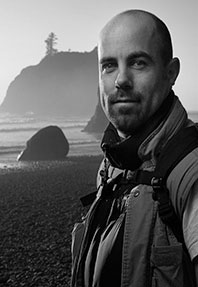
Images from Mount Rainier in the Pacific Northwest Of Washington State
My favorite time of the year for photographing nature is always wildflower season in the summer. There are many reasons why it’s my favorite season. The best reason is that you have an excuse to get out of the house and into nature. In the Pacific Northwest of the Western United States, you can find several different mountain ranges that showcase incredible wildflower meadows. I have to admit, initially, it was the attraction witnessing so amazing images from mountains like Mount Rainier and Mount St. Helens that drew me into wildflower photography. Specifically, I was drawn into the variety of different colors amongst the Wildflowers. The colorful meadows would go on forever with no end in sight. As soon as I first began photography, I was hiking anywhere I could to find wildflowers. Along the formative years of starting photographing wildflowers, I made a lot of mistakes. But slowly with every new season, I learned from my mistakes and got a little better. In this article, Here are my top ten tips for successful wildflower photography.

Images from Mt St Helens in Washington State
Firstly, an important part of the process is doing the research. This entitles using the Internet, books, and apps that help you identify when and where the flowers are. I begin this process, by researching the Internet where wildflowers can be found. There are many books as well as Internet sites that can be very specific about times and places. In addition, looking back at past seasons of when wildflowers peaked can be very helpful. Also, I search the Internet for wildflower forums and trip reports. In Washington, we have an organization called Washington Trails Association. It’s an active forum where like-minded people share information, images, and tips about specific hikes and trails. Encompassed in the application and site are downloadable GPS tracks. The fluctuation of wildflowers at their peak vary quite a bit, so make sure to combine your research from a variety of sources. Another great source for finding wildflowers is contacting the ranger station of the area. They can be a great source for out of the way locations that are harder to find. When I combine multiple sources for research and check recent trip reports I end up being very successful with wildflowers.

Images from Pinnacle Peak trail on Mount Rainier in the Pacific Northwest Of Washington State
The next step for achieving success with wildflower photography is having the right equipment. It is not necessary to have expensive equipment but there are a few important qualities that your camera and equipment should have. Using a tripod is a part of the process and should be used at all times when photographing flowers. The use of the tripod allows you to be specific with your composition and the flexibility to frame as needed. Using a tripod that is sturdy and strong will minimize movement of the camera. A tripod that is lighter and less solid can be move during the picture taking process. This causes the image to have a slight blur that can’t be seen on the LCD in the field. Cameras are improving at a fast rate and most cameras do a great job at producing quality images with little to no noise. The lenses used with the camera are a more important aspect. Over the last 12 years of photographing flowers, I have used several different lenses. Through experience, I have found that lenses that are faster and wider make a big difference when it comes to the overall impact of the image. Because the weight of flowers can be very delicate, any presence of wind can cause movement and reduce detail. Having a fast lens such as 2.8 can increase your shutter speed and reduce the chance of blurred images. You can also combine this with a much faster ISO, which will increase your shutter speed. Just be aware that increasing your ISO increases the overall noise in the image. It’s critical to find that balance of increasing the ISO but not so extreme that it introduces too much noise. For my aperture, I generally use f/13-f/16 unless the wind is very strong. In those situations, shoot the foreground flowers at a higher aperture like f/8 and shoot another image for the background at f/16 and combine the two in post-processing. Use of this technique is used only if the wind is so strong that the higher ISO would introduce too much noise in the overall image. When it comes to the aesthetics of flowers, I use wide-angle lenses in the 11-24mm range. The wide view allows more creative choices. Although this is a personal choice, I like to include as much of the foreground flowers as possible.

Images from Hurricane Ridge in Olympic National Park
Using quality equipment and good lenses leads us into the next subject of composition. As with most areas of photography, composition is a critical part of successful imagery. Wildflower photography is a highly visual and expressive art. Because the elements and textures are so bold it’s easy to include too much. Most photographers beginning, try to include too much when it comes to the elements. Because the display of wildflower meadows can be very busy and the final results can be chaotic and unorganized. It’s always better to include less and be more specific when it comes to composition. When it comes to discussing the techniques of composition, one of the most important aspects is color harmony. Because wildflowers are already saturated by nature, too much color can be overwhelming and a distraction from the overall impact. Color harmony if used with the right balance and amount can enhance the overall mood of the image. When shooting flowers, try to think in terms of warm and cool tones. The color wheel is a great subject to aid in learning about this subject. Use the color wheel as a reference and pay attention to your complementary colors. Frame the composition, so that the overall balance is not dominated by either warm or cool tones in any one region of the image. Each color has its own weight and having too much or not enough of that color on either side can pull the viewer’s eye out of the image. For example, the lupine in Washington has a purple color and thus a cool tone. I look to complement that cool color with a warmer tone flower such as Indian paintbrush, which is red. Having an image where there is a good mix of both these flowers, will be more visually aesthetic and pleasing to the eye of your viewer.

Images from Mt St Helens in Washington State
One of the most important aspects of wildflower photography is lighting. The use of lighting in your image can make or break an image. As with other subjects in photography, lighting whether natural or artificial can add necessary impact to the overall result. You can execute all the previously mentioned tips to perfection, but light is the one thing often overlooked when it comes to images that truly stand out. If light is used at the right time and direction, it can really bring attention to the main subject and interest of the image. Many photographers are under the impression that its best to shoot flowers during the day when sunlight is at is strongest; The problem is that mid-day light leads to harsh contrast. Very dark shadows and hot highlights strip the color from the flowers and results in a very unpleasing photograph. It’s best to photograph flowers in the very last few moments of the day, as the sun nears the horizon. The last few moments of spotlight showcase the flowers in warm soft light that really draw the viewers’ attention to the flowers. The sun is low enough on the horizon that the light has a soft and warm quality to it. Another good time to photograph wildflowers is when the sun is below the horizon or blocked. The wildflowers will be cast in soft cool light and the even contrast of the light across the scene makes for a pleasing color balance. So make sure to be cognizant of the light and its direction. If used in the right way it can make all the difference in the overall image.

Images from Idaho Peak in The East Kootenay Mountains Of British Columbia Canada
In summary, it goes a long way to have the right equipment and camera. Being aware of your camera settings and composition. Combining the following recommendations, with the right light, greatly increases the odds of capturing memorable wildflower images. Lastly, remember to dress appropriately for the adventure. Bring lots of clothing layers, as the mountains can be unpredictable especially at night. Most of all have fun; you are seeing nature at is best!

Website: www.kevinmcnealphotography.com
Facebook: https://www.facebook.com/kevinmcneal30
Instagram: www.instagram.com/kevinmcneal30
Flickr: https://www.flickr.com/photos/kevinmcneal
Kevin McNeal is a landscape photographer who resides in the Pacific Northwest of the U.S. He focuses on grand colorful landscapes that reflect the most unique places on earth. Capturing moments of magic light and transferring this on print, images behold a combination of perseverance, patience, and dedication to capture the images in ways unseen before. The stories of how these images are rendered come across in the feelings the images convey.

Recent Comments